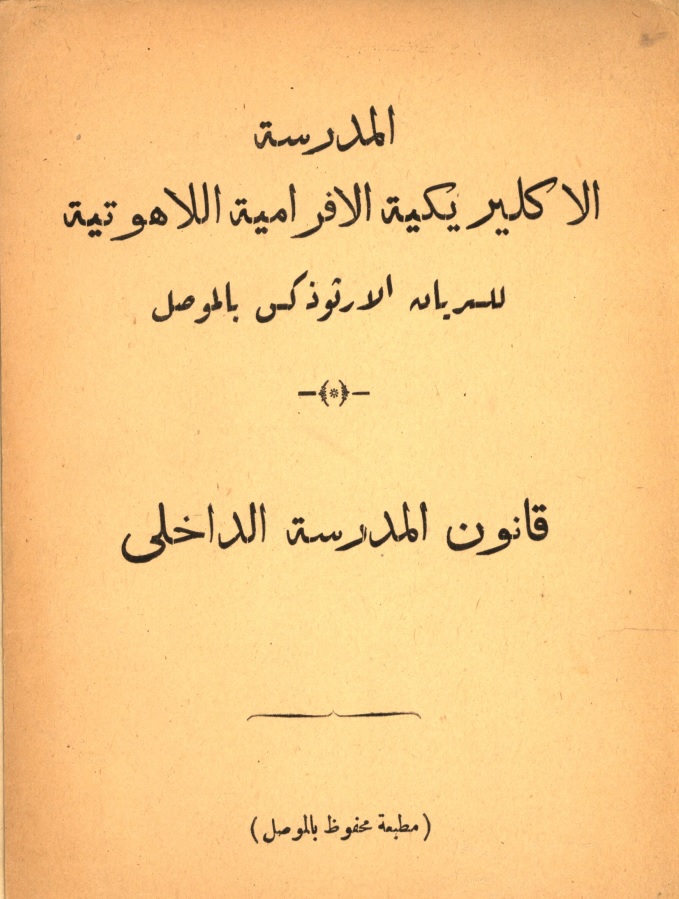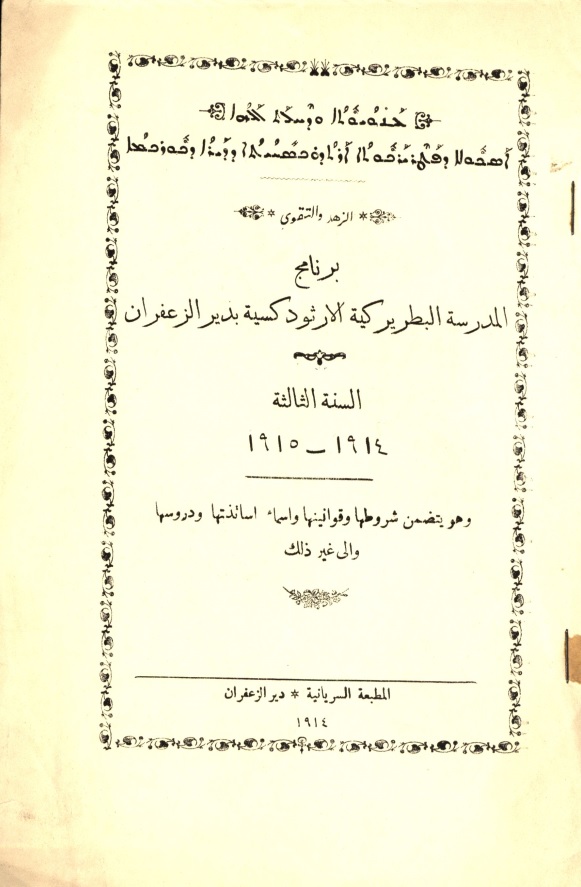Historical overview of Saint Aphrem Theological Seminary
The idea of establishing a clerical seminary and a theological institution for the Syriac Orthodox Church of Antioch was a dream of Syriac Patriarchs in modern times. By the help of God, what was once a dream became reality at the hands of Patriarch Aphrem Barsoum (+1957) of blessed memory, who, in 1934, built an appropriate building for this purpose in the city of Zahlé, Lebanon. Later, in 1939, he inaugurated the clerical institute under the name of “St. Aphrem Clerical School”. Since then, this establishment has gone through six stages that are summarized as follows.
First stage: St. Aphrem Clerical School, 1939-1946 (Zahlé, Lebanon)
This first stage was the phase of establishment and organization. The School had fifteen students, of which some taught and studied at the same time, and was under the supervision of its director: His Holiness Patriarch Aphrem I Barsoum.
Second stage: St. Aphrem Clerical School, 1946-1962 (Mosul, Iraq)
For many reasons, the school was relocated from Zahlé to Mosul Iraq in 1946. It was set up at a building next to Al-Tahra Church. It moved rapidly towards success and provided the Church with an elite group of graduates.
Third stage: St. Aphrem Clerical School, 1962-1968 (Zahlé, Lebanon)
Yet again, for urgent reasons and pressing circumstances, Patriarch Mor Ignatius Jacob III of blessed memory brought it back to its old location in the city of Zahlé, Lebanon in 1962.
Fourth stage: St. Aphrem Clerical School, 1968-1982 (Atchaneh, Lebanon)
Patriarch Mor Ignatius Jacob III of blessed memory had constructed a special building for the School in Atchaneh, Lebanon. The School moved to Atchaneh and remained there until 1976, when its doors were closed due to the civil war in Lebanon. The students were obliged to return to their homes and countries. During the academic year 1977-1978, the Clerical School reopened its doors in Atchaneh and twelve students enrolled it, but the School did not persist and students had to move to Damascus during the academic year 1978-1979. Later, they returned to Atchaneh between 1979-1982.
Fifth stage: Saint Aphrem Clerical Institute, 1984-1996 (Damascus, Syria)
When the late Patriarch Mor Ignatius Zakka I Iwas of blessed memory was installed in 1980, he gave special attention to this institution. In 1981, during the first Synod following the election of His Holiness, the topic of this institution was the most important item of the meeting’s agenda. The issue was studied in depth and the Fathers of the Synod decided to elevate its academic and spiritual level. An episcopal committee was formed to carry on the work, and to relocate the institute to Maʿarrat Saydnaya, after preparing the building.
In February of 1984, the Holy Synod decided to make Damascus the temporary headquarters of the Institute, under the direct supervision of His Holiness, until its permanent building at Maʿarrat Saydnaya was completed. In accordance with the decision of the Synod, His Holiness opened the Institute in Damascus on October 1, 1984. An old building in Haret Al-Zeitoun, Bab Sharqi, was chosen as its headquarters. His Holiness restored it and built new rooms. The number of students was more than thirty. A new code was adopted and the academic regulations were revised. Being the supreme head of the Institute, His Holiness devoted much of his time to manage the Institute and to give some lectures to the advanced classes.
His Holiness worked on raising the level of the Institute to that of other theological colleges in the Middle East, which required improving the educational curriculum and increasing the teaching staff.
Sixth stage: Saint Aphrem Theological Seminary, 1996 – today (Saint Aphrem Monastery, Maʿarrat Saydnaya, Damascus, Syria)
Saint Aphrem Theological Seminary was moved from its old headquarters in Al-Zeitoun to Saint Aphrem Monastery in Ma’arrat Saydnaya, its new headquarters, on September 14, 1996. The Seminary started its work on October 26, 1996, and it improved constantly especially when some monks, who were formerly sent abroad by the late Patriarch to continue their advanced studies, returned to teach in it.
Today, His Holiness Patriarch Mor Ignatius Aphrem II is working to strengthen its faculty and to develop its curriculum as to match international academic standards. On this account, it is well on the way to becoming a Theological Faculty within the new Syriac University to be built in Ma’arrat Saydnaya.
المدرسة الاكليريكية الافرامية اللاهوتية للسريان الأرثوذكس بالموصل
قانون المدرسة الداخلي- مطبعة محفوظ بالموصل
برنامج المدرسة البطريركية الارثوذكسية بدير الزعفران
السنة الثالثة 1914 – 1915 وهو يتضمن شروطها وقوانينها وأسماء اساتذتها ودروسها والى غير ذلك – المطبعة السريانية دير الزعفران 1914


